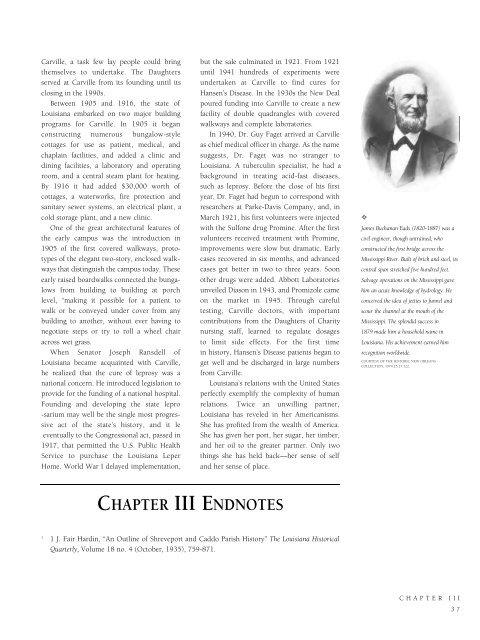Historic Louisiana
An illustrated history of Louisiana, paired with the histories of companies, families and organizations that make the state great.
An illustrated history of Louisiana, paired with the histories of companies, families and organizations that make the state great.
You also want an ePaper? Increase the reach of your titles
YUMPU automatically turns print PDFs into web optimized ePapers that Google loves.
Carville, a task few lay people could bring<br />
themselves to undertake. The Daughters<br />
served at Carville from its founding until its<br />
closing in the 1990s.<br />
Between 1905 and 1916, the state of<br />
<strong>Louisiana</strong> embarked on two major building<br />
programs for Carville. In 1905 it began<br />
constructing numerous bungalow-style<br />
cottages for use as patient, medical, and<br />
chaplain facilities, and added a clinic and<br />
dining facilities, a laboratory and operating<br />
room, and a central steam plant for heating.<br />
By 1916 it had added $30,000 worth of<br />
cottages, a waterworks, fire protection and<br />
sanitary sewer systems, an electrical plant, a<br />
cold storage plant, and a new clinic.<br />
One of the great architectural features of<br />
the early campus was the introduction in<br />
1905 of the first covered walkways, prototypes<br />
of the elegant two-story, enclosed walkways<br />
that distinguish the campus today. These<br />
early raised boardwalks connected the bungalows<br />
from building to building at porch<br />
level, “making it possible for a patient to<br />
walk or be conveyed under cover from any<br />
building to another, without ever having to<br />
negotiate steps or try to roll a wheel chair<br />
across wet grass.<br />
When Senator Joseph Ransdell of<br />
<strong>Louisiana</strong> became acquainted with Carville,<br />
he realized that the cure of leprosy was a<br />
national concern. He introduced legislation to<br />
provide for the funding of a national hospital.<br />
Founding and developing the state lepro<br />
-sarium may well be the single most progressive<br />
act of the state’s history, and it le<br />
eventually to the Congressional act, passed in<br />
1917, that permitted the U.S. Public Health<br />
Service to purchase the <strong>Louisiana</strong> Leper<br />
Home. World War I delayed implementation,<br />
but the sale culminated in 1921. From 1921<br />
until 1941 hundreds of experiments were<br />
undertaken at Carville to find cures for<br />
Hansen’s Disease. In the 1930s the New Deal<br />
poured funding into Carville to create a new<br />
facility of double quadrangles with covered<br />
walkways and complete laboratories.<br />
In 1940, Dr. Guy Faget arrived at Carville<br />
as chief medical officer in charge. As the name<br />
suggests, Dr. Faget was no stranger to<br />
<strong>Louisiana</strong>. A tuberculin specialist, he had a<br />
background in treating acid-fast diseases,<br />
such as leprosy. Before the close of his first<br />
year, Dr. Faget had begun to correspond with<br />
researchers at Parke-Davis Company, and, in<br />
March 1921, his first volunteers were injected<br />
with the Sulfone drug Promine. After the first<br />
volunteers received treatment with Promine,<br />
improvements were slow but dramatic. Early<br />
cases recovered in six months, and advanced<br />
cases got better in two to three years. Soon<br />
other drugs were added. Abbott Laboratories<br />
unveiled Diason in 1943, and Promizole came<br />
on the market in 1945. Through careful<br />
testing, Carville doctors, with important<br />
contributions from the Daughters of Charity<br />
nursing staff, learned to regulate dosages<br />
to limit side effects. For the first time<br />
in history, Hansen’s Disease patients began to<br />
get well and be discharged in large numbers<br />
from Carville.<br />
<strong>Louisiana</strong>’s relations with the United States<br />
perfectly exemplify the complexity of human<br />
relations. Twice an unwilling partner,<br />
<strong>Louisiana</strong> has reveled in her Americanisms.<br />
She has profited from the wealth of America.<br />
She has given her port, her sugar, her timber,<br />
and her oil to the greater partner. Only two<br />
things she has held back—her sense of self<br />
and her sense of place.<br />
✧<br />
James Buchanan Eads (1820-1887) was a<br />
civil engineer, though untrained, who<br />
constructed the first bridge across the<br />
Mississippi River. Built of brick and steel, its<br />
central span stretched five hundred feet.<br />
Salvage operations on the Mississippi gave<br />
him an acute knowledge of hydrology. He<br />
conceived the idea of jetties to funnel and<br />
scour the channel at the mouth of the<br />
Mississippi. The splendid success in<br />
1879 made him a household name in<br />
<strong>Louisiana</strong>. His achievement earned him<br />
recognition worldwide.<br />
COURTESY OF THE HISTORIC NEW ORLEANS<br />
COLLECTION, 1974.25.27.122.<br />
CHAPTER III ENDNOTES<br />
1<br />
1 J. Fair Hardin, “An Outline of Shreveport and Caddo Parish History” The <strong>Louisiana</strong> <strong>Historic</strong>al<br />
Quarterly, Volume 18 no. 4 (October, 1935), 759-871.<br />
CHAPTER III<br />
37
















